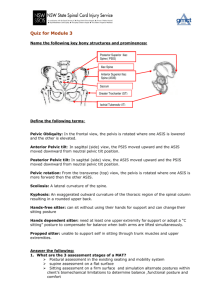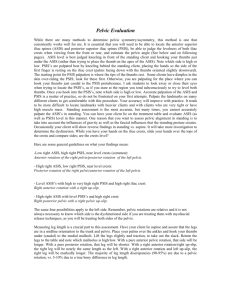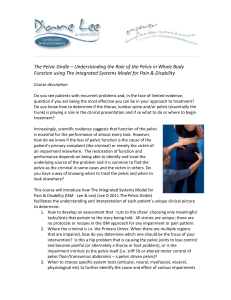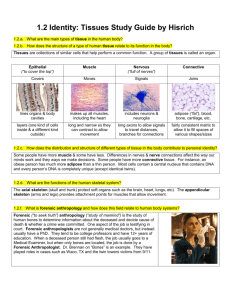Development of an Optimization Method for Locating the Pelvis in an
advertisement
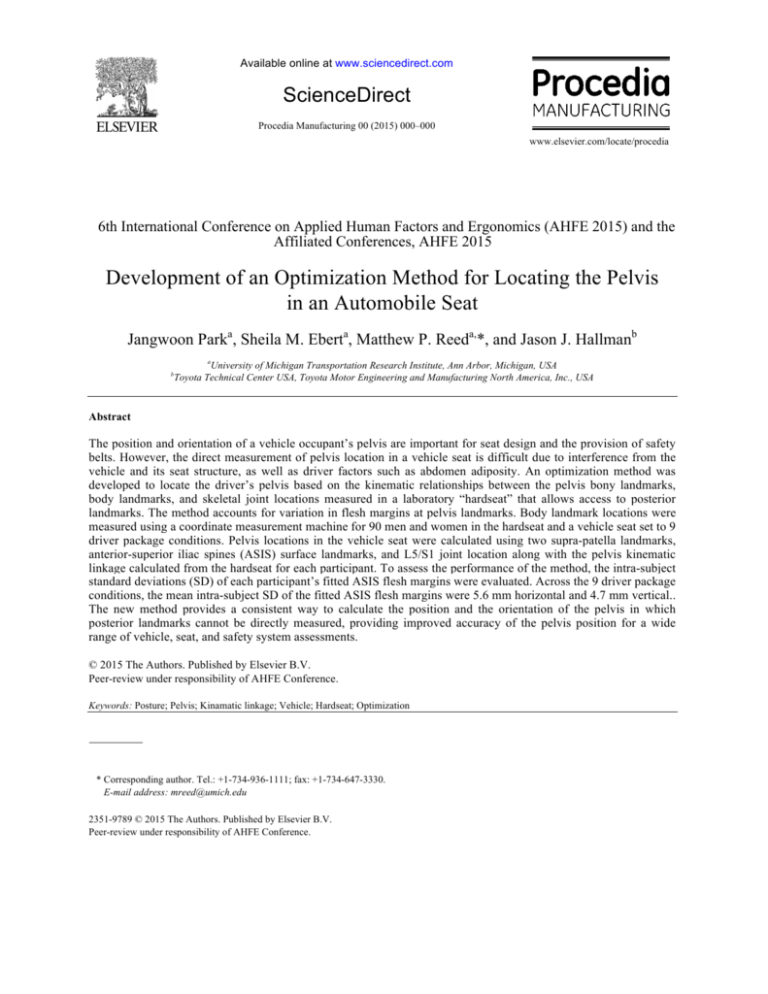
Available online at www.sciencedirect.com ScienceDirect Procedia Manufacturing 00 (2015) 000–000 www.elsevier.com/locate/procedia 6th International Conference on Applied Human Factors and Ergonomics (AHFE 2015) and the Affiliated Conferences, AHFE 2015 Development of an Optimization Method for Locating the Pelvis in an Automobile Seat Jangwoon Parka, Sheila M. Eberta, Matthew P. Reeda,*, and Jason J. Hallmanb b a University of Michigan Transportation Research Institute, Ann Arbor, Michigan, USA Toyota Technical Center USA, Toyota Motor Engineering and Manufacturing North America, Inc., USA Abstract The position and orientation of a vehicle occupant’s pelvis are important for seat design and the provision of safety belts. However, the direct measurement of pelvis location in a vehicle seat is difficult due to interference from the vehicle and its seat structure, as well as driver factors such as abdomen adiposity. An optimization method was developed to locate the driver’s pelvis based on the kinematic relationships between the pelvis bony landmarks, body landmarks, and skeletal joint locations measured in a laboratory “hardseat” that allows access to posterior landmarks. The method accounts for variation in flesh margins at pelvis landmarks. Body landmark locations were measured using a coordinate measurement machine for 90 men and women in the hardseat and a vehicle seat set to 9 driver package conditions. Pelvis locations in the vehicle seat were calculated using two supra-patella landmarks, anterior-superior iliac spines (ASIS) surface landmarks, and L5/S1 joint location along with the pelvis kinematic linkage calculated from the hardseat for each participant. To assess the performance of the method, the intra-subject standard deviations (SD) of each participant’s fitted ASIS flesh margins were evaluated. Across the 9 driver package conditions, the mean intra-subject SD of the fitted ASIS flesh margins were 5.6 mm horizontal and 4.7 mm vertical.. The new method provides a consistent way to calculate the position and the orientation of the pelvis in which posterior landmarks cannot be directly measured, providing improved accuracy of the pelvis position for a wide range of vehicle, seat, and safety system assessments. © 2015 The Authors. Published by Elsevier B.V. Peer-review under responsibility of AHFE Conference. Keywords: Posture; Pelvis; Kinamatic linkage; Vehicle; Hardseat; Optimization * Corresponding author. Tel.: +1-734-936-1111; fax: +1-734-647-3330. E-mail address: mreed@umich.edu 2351-9789 © 2015 The Authors. Published by Elsevier B.V. Peer-review under responsibility of AHFE Conference. 2 Author name / Procedia Manufacturing 00 (2015) 000–000 1. Introduction Pelvis position and orientation are important aspects of a vehicle occupant’s posture. Measurements of drivers’ or passengers’ pelvis locations are used for ergonomic or crash safety studies such as development of postureprediction models [11], analysis of lap belt-fit [9], and development of computational human models [4]. However, the direct measurement of pelvis bony landmarks such as anterior-superior iliac spines (ASIS) and posterior-superior iliac spines (PSIS) is difficult due to interference from the vehicle, its seat structure, and occupant factors such as abdomen adiposity. Two approaches (anatomical vs. kinematic) have been developed to predict pelvis bony landmarks. Bell et al. (1989) established scaling ratios to predict hip-joint-center (HJC) location based on the anatomical relationship between pelvis bony landmarks and pelvic width (left ASIS to right ASIS). Manary et al. [6] used these scaling ratios to find 40 drivers’ HJC locations in automobile seats using the digitized body surface landmarks. In the other approach, several previous studies [2, 3, 5, and 7] developed functional methods to predict HJC location based on the kinematic relationship between HJC location and rigid body linkage. For example, Bush and Gutowski [2] developed a functional method to predict HJC location as the center of sphere of the femur rotation relative to the pelvis. Although the scaling ratios are useful to estimate the pelvis location for a normal weight driver, they are problematic for locating the pelvis for occupants with large abdomens. Reed et al. [9] found that a driver’ ASIS flesh margin significantly varied with body mass index (BMI). Most previous studies assumed constant flesh margin. This paper presents a new method to locate a driver’s pelvis from accessible surface landmarks by considering the ASIS flesh margin and the kinematic relationship between pelvis bony landmarks, digitized body surface landmarks, and skeletal joint locations. 2. Methods 2.1. Participants Ninety participants (47 women and 43 men) with a wide range of body sizes were recruited through online advertisements, newspaper, and word of mouth. The average stature, weight, and BMI of the participants were 1,683 mm (SD = 112; range = 1,435 ~ 1,965 mm), 78.4 kg (SD = 18.6; range = 44.1 ~ 139.4 kg), and 27.6 kg/m2 (SD = 5.2; range = 18.4 ~ 48.5 kg/m2), respectively. Written informed consent was obtained using procedures approved by the University of Michigan Institutional Review Board for Health Behavior and Health Sciences. The participants wore test garments made of thin material that provided good access to body landmarks. 2.2. Apparatus A laboratory hardseat (Fig 1.a) was constructed to enable measurement of the posterior spine and pelvis landmarks such as PSISs that are inaccessible on an automobile seat. The hardseat has a 14.5° fixed cushion angle and a 23° fixed seatback angle designed to produce postures similar to those in an automobile seat. The driver mockup (Fig 1.b) was constructed using components from a 2010 Toyota Highlander that were modified to achieve a high level of adjustability. In both the hard-seat and driver mockup, the three-dimensional coordinate measuring machine (FARO Arm®, FARO Technology, USA) was used to record the locations of body surface landmarks. The three dimensional coordinate system in the present study was defined following Society of Automotive Engineers (SAE) J1100 [13]: the x-axis is positive rearward, the y-axis is positive to the driver’s right, and the z-axis is positive upward. Author name / Procedia Manufacturing 00 (2015) 000–000 3 (a) hardseat and recording a participant’s posterior-superior iliac spines (PSIS) landmark location. (b) driver mockup and recording body landmark locations using a FARO Arm coordinate digitizer Fig 1. Constructed hardseat and driver mockup to measure body surface landmark locations. 2.3. Measurement of body surface landmarks in the hardseat and vehicle seat Body surface landmarks of 90 drivers were palpated and digitized in the hardseat and the vehicle seat set to 9 package conditions (SAE L6 = 550, 600, 650 mm for SAE H30 180 mm; L6 = 500, 550, 600 mm for H30 270 mm, and L6 = 450, 500, 550 mm for H30 360 mm). For example, the locations of left and right ASIS on the participants’ body surfaces were firmly pressed and then digitized by trained investigators. Landmark definitions were identical to those presented in previous studies [10, 12]. 2.4. Development of pelvis fitting method 2.4.1. Estimation of joint locations and pelvis geometry using the hardseat data The locations of internal joint centers defining a driver’s kinematic linkage were estimated using the hardseat data into four steps (see Fig 2). First, the C7/T1 and T12/L1 joint locations were calculated by the Reed et al. [8] models. For example, the C7/T1 joint location was calculated using the C7 and suprasternale surface landmarks as shown in Fig 3. The vector from C7 to suprasternale is rotated upward 8° and scaled to have a length equal to 55 percent of the measured sagittal-plane distance from C7 to suprasternale. Second, the ASIS and PSIS flesh margins, pelvic depth (PD), and bi-ASIS breadth were estimated by in a local pelvic coordinate system using scaling methods described in [9]. Third, the bone ASIS and PSIS locations were estimated using the afore-predicted ASIS and PSIS flesh margins, and PD along the vector from surface ASIS to PSIS. Lastly, the L5/S1 and hip joints for male and female drivers were separately estimated using the bone ASIS and PSIS locations (see [8, 9], for details about pelvis bony landmark prediction in a local pelvic coordinate system). 4 Author name / Procedia Manufacturing 00 (2015) 000–000 C7digitized suprasternaledigitized ASISdigitized PSISdigitized BMImeasured Calculation of C7/T1 and T12/L1 joint locations Estimation of ASIS and PSIS flesh margins, pelvic depth (PD), bi-ASIS breadth (BB) Calculation of ASIS and PSIS bone locations using the predicted ASIS and PSIS flesh margins, PD, and BB gender Estimation of L5/S1 and hip joint locations Fig. 2. Estimation procedure for a driver’s inner joint and pelvis bony landmark locations using hardseat data [8, 9]. +z -x C7 C7/T1 suprasternale substernale T8 94° T12/L1 suprapatella T12 ASISsurface L5/S1 PSISbone PSISsurface hip joint ASISbone Fig. 3. Calculation methods for torso joint locations in a sagittal plane [8]. 2.4.2. Translation and orientation of estimated femur-pelvis-lumbar segment locations using the vehicle data The pelvis fitting method in this study is based on four assumptions: (1) The pelvis and lumbar segment lengths are fixed at the values estimated from the harseat data. (2) The digitized left and right suprapatella body surface landmarks in the vehicle seat are accurate and have a fixed relationship to the underlying bones. (3) The estimated Author name / Procedia Manufacturing 00 (2015) 000–000 5 T12/L1 joint location in the vehicle seat is accurate. (4) The left and right ASIS flesh margins are identical, which means that the surface ASIS values accurately capture pelvis yaw and roll about the pelvis vertical and fore-aft axes, respectively (see Figure 4). The remaining degrees of freedom to be fitted are pelvis translation (horizontal and vertical) and pitch (about the pelvis lateral axis). Based on these assumptions, the pelvis fitting was conducted for the vehicle-seat measurements in two steps. First, the midpoint between the estimated bone ASIS in the hardseat data was aligned to the midpoint between the digitized ASIS in the vehicle data on the vertical plane (see Fig 5). Next, an optimization technique was employed to position the center of the pelvis via two translations (ΔX and ΔZ) and one rotation (Δβpitch). The L5/S1 joint is limited to a sphere around the estimated T12/L1 joint in the vehicle data with the given lumbar segment length. T12/L1 ASISright, digitized ASISright T12/L1 L5/S1 ASISleft x x c c suprapatella Hip joint suprapatella ASISleft, digitized Fig. 4. Illustration of digitized body landmarks, estimated joint locations, and pelvis bony landmarks in the hardseat (left) and the vehicle seat (right), respectively. The dotted line in the left image shows pelvis-lumbar segments. T12/L1 ASIS flesh margin ASIS +Z L5/S1 ASISdig. lumbar length PSIS βpitch +X hip joint Fig. 5. The three dimensional coordinate system to translate and rotate the pelvis geometry. 6 Author name / Procedia Manufacturing 00 (2015) 000–000 The objective function (see Eq. 1) was set as minimization of the sum of discrepancies between the estimated hip-to-suprapatella (HTS) lengths in the hardseat and newly fitted ones in the vehicle seat. The constraints (see Eq. 2) were set using the lumbar length. Lastly, the lower and upper bounds of each design variable (ΔX, ΔZ, and Δβpitch) were set by considering the feasible range of pelvis positions. The optimization was conducted using the fmincon constrained minimization function from the Matlab® Optimization Toolbox (2014a, MathWorks, Inc., USA). Minimize: (HTSleft, hardseat − HTSleft, new )2 + (HTSright, hardseat − HTSright, new )2 (Eq. 1) Subject to: $ lumbar length fitted = lumbar length hardseat , & &0 mm ≤ ΔX ≤ 200 mm, % &−30 mm ≤ ΔZ ≤ 0 mm, &'−30° ≤ Δβpitch ≤ 10°, (Eq. 2) 3. Results The intra-subject standard deviation (SD) of fitted ASIS flesh offsets were calculated. Across the 9 driver package conditions, the mean intra-subject SDs of ASIS offset were 5.6 mm horizontal and 4.7 mm vertical. In addition, the intra-subject SD of left and right femur lengths were calculated using the knee joints and the fitted hip joints. Across the 9 driver package conditions, the mean intra-subject SDs of femur lengths were 18.6 mm for left and 19.6 mm for right. Lastly, the fitted pelvis angles were seen to fit a normal distribution with mean of 48.3° (SD = 10.4°), similar to the pelvis angles in the hardseat data (mean = 47.3°, SD = 8.8°). 4. Discussion A new method was developed to estimate pelvis position and orientation in an automobile seat by considering the subject-specific ASIS flesh margin information and the kinematical relationship in body linkage system through reference to data obtained in a laboratory seat that allowed access to posterior landmarks. The lower and upper bounds of rotation were restricted to avoid toggle errors in the fitting. The seat height (H30) and steering wheel location (L6) in the test conditions varied widely from 180 mm to 360 mm and from 450 mm to 650 mm, so the pitch angle can be varied. However, without restriction of pitch angle, there might have a change to toggle errors in the fitting. So, the present study set boundary of pitch angle (30° for clockwise and 10° for counter-clockwise rotation) to avoid fitting errors. Also, the upper and lower bounds of the vertical axis translation were restricted to no more than 30 mm below the digitized intra-ASIS location avoid local minima with clearly erroneous pelvis location estimates. The small intra-subject SDs of ASIS horizontal and vertical offsets and femur lengths across driver package conditions indicate good repeatability of the current method. Future studies to validate the current pelvis fitting method using radiographic data in automotive seats would be valuable. Acknowledgements This research was sponsored by the Toyota Collaborative Safety Research Center. We thank our collaborators at the CSRC who contributed significantly to this work, including Chuck Gulash, Megan Mackenzie, Jason Hallman, and Palani Palaniappan. Many people at UMTRI contributed to the success of this project, including Brian Eby, Charlie Bradley, Steven Thomas, and Stewart Simonett, who developed the mockups and fixtures. Laura Malik and Jamie Moore led the data collection, assisted by numerous student research assistants, including Alexis Baker, Olivia DeTroyer, Tiffany Fredrick, Mollie Pozolo, Rachel Palmer, Sarah Scholten, and Lindsay Youngren. These students were assisted in data processing and scan landmark extraction by Christian Calyore, David Hayashi, Danielle Hedden, Jordan MacDonald, Huibin Hu, Ryan Warner, and Mikhail Wise. Author name / Procedia Manufacturing 00 (2015) 000–000 7 References [1] Bell, A.L, Brand, R.A., & Pedersen, D.R. (1989). Prediction of hip joint center location from external landmarks. Human Movement Science, 8, 3-16. [2] Bush, T.R, & Gutowski, P.E. (2003). An approach for hip joint center calculation for use in seated postures. Journal of Biomechanics, 36, 1739-1743. [3] Camomilla, V., Cereatti, A., Vannozzi, G., & Cappozzo, A. (2006). An optimized protoco for hip joint centre determination using the functional method. Journal of Biomechanics, 39, 1096-1106. [4] Hu, J., Rupp, J.D., & Reed, M.P. (2012). Focusing on vulnerable populations in crashes: recent advances in finite element human models for injury biomechanics research. Journal of Automotive Safety and Energy, 3(4), 295-307. [5] Leardini, A., Cappozzo, A., Catani, F., Toksvig-Larsen, S., Petitto, A., Sforza, V., Cassanelli, G., & Giannini, S. (1999). Validation of a functional method for the estimation of hip joint center location. Journal of Biomechanics, 32, 99-103. [6] Manary, M.A, Schneider, L.W., Flannagan, C.C., & Eby, B.H. (1994). Evaluation of the SAE J826 3-D manikin measures of driver positioning and posture. SAE Technical Paper 941048. SAE International, Warrendale, PA. [7] Piazza, S.J, Okita, N., & Cavanagh, P.R. (2001). Accuracy of the fucntional method of hip joint center location: effects of limited motion and varied implementation. Journal of Biomechanics, 34, 967-973. [8] Reed, M.P., Manary, M.A., and Schneider, L.W. (1999). Methods for measuring and representing automobile occupant posture. Technical Paper 990959. Proceedings of the SAE International Congress and Exposition, Society of Automotive Engineers, Warrendale, PA . [9] Reed, M.P., Ebert, S.M., & Hallman, J.J. (2013). Effects of driver characteristics on seat belt fit. Stapp Car Crash Journal, 57, 43-57. [10] Reed, M.P., Manary, M.A., Flannagan, C.A.C. & Schneider, L.W. (2000). Effects of vehicle interior geometry and anthropometric variables on automobile driving posture. Human Factors, 42(4), 541–552. [11] Reed, M.P., Manary, M.A., Flannagan, C.A.C. & Schneider, L.W. (2002). A statistical method for predicting automobile driving posture. Human Factors, 44(4), 557–568. [12] Reed, M.P., Manary, M.A., & Schneider, L.W. (1999). Methods for measuring and representing automobile occupant posture. SAE Technical Paper 990959. SAE International, Warrendale, PA. [13] Society of Automotive Engineers (SAE) J1100 (2009). Motor Vehicle Dimensions. Warrendale, PA: Society of Automotive Engineers, Inc.
